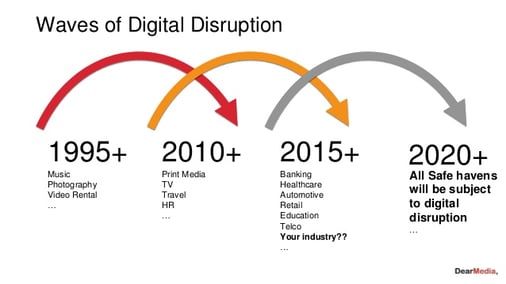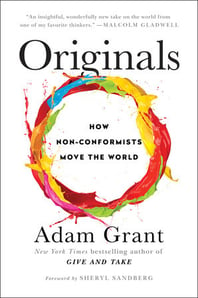A quick reminder why you and your business absolutely need to innovate.
 This chart reminds how digital disruption affects the economy, and thousands of businesses. More disruption is coming. It’s why Scaling Up author Verne Harnish insists in the future every business will be a software business. The result: if your business isn’t already impacted, it will be, very soon.
This chart reminds how digital disruption affects the economy, and thousands of businesses. More disruption is coming. It’s why Scaling Up author Verne Harnish insists in the future every business will be a software business. The result: if your business isn’t already impacted, it will be, very soon.
Preparing isn’t the answer.
Learning how to become a disruptive innovator is.
The Outthinker Process, an essential training/learning tool, was essential to my customers Annual Planning & Strategy sessions this past year. If it’s not in your plan for 2018, you need to rethink your plans/strategy!
Adam Grant’s Originals is an excellent complement to Kaihan Krippendorff’s Outthink the Competition: How a New Generation of Strategists Sees Options Others Ignore.
Winning & Losing Moves
Why do some ideas succeed and others do not? In Originals, Grant explores why innovations like the Segway fail, and so many publishers rejected J.K. Rowling’s hugely successful Harry Potter ($25 Billion revenue as of 2015)?
In the face of uncertainty, our first instinct is often to reject novelty, looking for reasons why unfamiliar concepts might fail. When managers vet novel ideas, they’re in an evaluative mindset. To protect themselves against the risks of a bad bet, they compare the new notion on the table to templates of ideas that have succeeded in the past. When publishing executives passed on Harry Potter, they said it was too long for a children’s book; when Brandon Tartikoff saw the Seinfeld pilot, he felt it was “too Jewish” and “too New York” to appeal to a wide audience.
The question is, how do we recognize winning from losing moves? How can we trust our judgement, our expertise?
 In Originals: How Non-Conformists Move the World, Adam Grant helps define the parameters for who can assess innovations better. When to trust yourself and when not to.
In Originals: How Non-Conformists Move the World, Adam Grant helps define the parameters for who can assess innovations better. When to trust yourself and when not to.
Creative Mindset
“Creativity is allowing yourself to make mistakes. Art is knowing which ones to keep.” ~ Scott Adams
Who are the best at evaluating innovative ideas? Researchers have discovered, peers, managers, test audiences, all fail to predict with any degree of accuracy the success or failure innovative ideas.
You’d think someone like Steve Jobs would know creativity and innovation when he sees it. Jobs was so convinced the Segway would be successful, when the Segway inventor turned down his offer to invest $63 million for 10% of the company, he did something completely out of character. He offered to advise the inventor the next six months, free!
Amazon founder Jeff Bezos took one look at the product and immediately got involved, telling the inventor, “You have a product so revolutionary, you’ll have no problem selling it.” John Doer, the legendary investor who bet successfully on Google and many other blue-chip startups, pumped $80 million into the business, predicting that it would be the fastest company ever to reach $1 billion and “would become more important than the internet.”
The Segway is an abject failure!
The inventor, Dean Kamen, projected within a year, sales of Segway would reach 10,000 units a week. Six years later, only about 30,000 units had sold. After more than a decade, the company still hadn’t become profitable.
If people like Steve Jobs, Jeff Bezos, and successful investors like John Doerr fail to recognize innovative ideas, how can we, in our business choose winners?
Reliable Judgement
Comedians often say that the highest badge of honor is to make a fellow comic laugh; magicians like fooling audiences but live to baffle their brethren. The usual explanation for this preference is status striving: we crave acceptance by our peer group, those similar to us. Research suggests we’re also drawn to peer evaluations because they provide the most reliable judgments.
 There is one group of forecasters that does come close to attaining mastery: fellow creators evaluating one another’s ideas.
There is one group of forecasters that does come close to attaining mastery: fellow creators evaluating one another’s ideas.
How do you create this same type of forecasting in your company? How does your business choose which ideas to develop, and which ideas to junk?
There are two important aspects to this process. The Outthinker Process my customers worked on in their Annual Strategy & Planning, provides two critical elements Adam Grant’s book Originals: How Non-Conformists Move the World, recommends following to develop tons of ideas, and how to make good decisions on how to choose which to develop and which to throw away.
We’ll explore these two critical decision-making tools in our next blog.
Achieving growth demands Strategic Discipline.
Positioning Systems helps mid-sized ($5M - $250M) business Scale-UP. We’re experts at helping you determine Your One Thing! We also help your business learn best practices, and how to evolve in a rapidly changing economic environment. Are you avoiding a conversation with yourself on how you can grow your business? Contact dwick@positioningsystems.com to Scale Up your business! Take our Four Decisions Needs Assessment to discover how your business measures against other Scaled Up companies. We’ll contact you.
Innovating – Two Critical Decision Tools – Next blog
How do you sharpen your ability to identify great new products and services for your business? Whether you’re generating or evaluating new ideas, the best you can do is measure success on the kind of yardstick that batters use in baseball. As Randy Komisar puts it, “If I’m hitting .300, I’m a genius. That’s because the future cannot be predicted. The sooner you learn it, the sooner you can be good at it.” We’ll explore how you can bat .300 next blog.






.jpeg?width=150&height=135&name=Hand%20with%20marker%20writing%20the%20question%20Whats%20Next_%20(1).jpeg)

